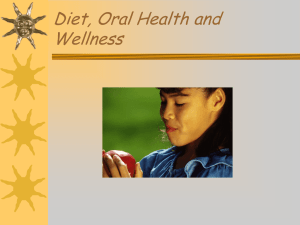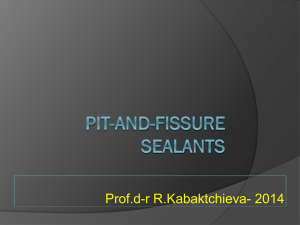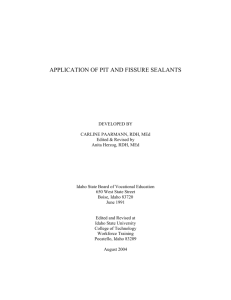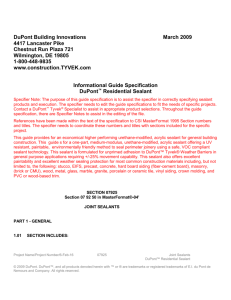Pit and Fissure Sealants
advertisement
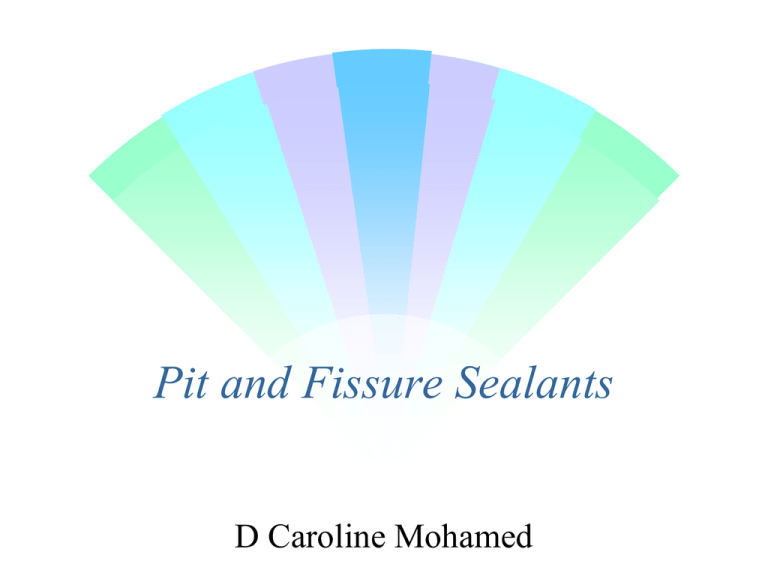
Pit and Fissure Sealants D Caroline Mohamed Pit and fissure sealants A thin plastic coating placed in the pit and fissures of the teeth to act as a physical barrier to decay Why pit & fissure sealants needed Bacteria produces acid which causes decay “demineralization” Pit and fissure sealants Over 85% of children (5-17 years old) in US have caries in the pits and fissures Fluoride is least effective on pit and fissures Only 18% of school-aged children in US have sealants Effectiveness of sealants 15 year study – 68% of sealed teeth were caries free vs 17% of unsealed control group Other Preventive Programs Community water fluoridation School water fluoridation Fluoridated toothpaste Fluoride mouthrinse In-office treatment 50-60% (18-40%) 40% 15-30% 31% 26% Preventive Programs as Related to Sealants Tooth brushing and flossing - mechanical plaque removal Fluoride – chemical prevention Dental visits – mechanical plaque removal and chemical prevention Preventive Programs as Related to Sealants - continued Diet Minimize exposure to cariogenic foods and liquids that have little or no nutritional value Minimize solid and sticky foods Minimize slowly dissolving foods History of Sealants Acrylic polymers introduced to dentistry – 1937 Composites - 1960 “Occlusal Sealing” – 1965 Glass ionomers – 1972 Retention of Sealants – 4 year study Fluoride releasing sealant 91% retention (77% complete & 14% partial) 10% caries rate Non-fluoride releasing sealant 95% retention (89% complete & 6% partial) 10% caries rate Retention of Sealants – 2 year study Fluoride releasing sealant >90% retention No caries Sealant retention Sealant Failure Debris and/or saliva contamination Air inclusion during manipulation – voids Manipulating self-cured sealants late in the setting reaction Loss of Sealant A contaminated site from faulty technique will likely result in complete or partial loss of the sealant within 6-12 months. Cost Factors Dental Sealants = $25 - $49 per tooth Amalgam = $75 to $145 per filling Composite = $150 to $200 for a single surface white composite filling Medical reimbursement Insurance reimbursement Preventive Resin Restoration The preparation of fissures by use of air abrasion, bur or laser followed by filling the prep with a flowable composite. Incipient Caries Studies have shown that sealants can be placed over incipient caries which arrests the caries process Most dentists choose to use air abrasion, a bur, or a laser to remove the caries before the sealant is placed Tooth morphology Pits and fissures Tooth morphology Tooth morphology Tooth morphology Why fissures are caries susceptible Selection of teeth Considerations Patient age Oral hygiene Caries risk Diet Fluoride history Tooth type Morphology Selection of teeth - continued Frequency of pit & fissure caries Lower molars – 50% Upper molars 35-40% Upper and lower second premolars Upper laterals and upper first premolars Upper centrals and lower first premolars Indications Deep fissures Incomplete or ill formed pits Newly erupted teeth High caries rate Children Molars Contraindications Shallow fissures Well coalesced pits Fluoride rich enamel Low caries rate Occlusal or proximal caries Adults Partially erupted teeth? To seal or not to seal? Operculum (gum flap) – leaks crevicular fluid Sealant Kits Cavity Indicators Drying and/or bonding agent (optional) Acid etch Sealant material Acid Etch Gel Liquid 3M Innovation: Adper™ Prompt™ LPop™ Self-Etch Adhesive Acid etch Phosphoric acid 35%-40%-50% Dissolves organic portion of enamel “micromechanical retention” Acid etch - continued Creates more surface area for better adhesion Also high energy surface Acid etch - Precautions Avoid contact with adjacent teeth or soft tissues Can use mylar strips or matrix bands Acid etch –Precautions cont. Active ingredient – phosphoric acid Avoid contact with skin, eyes, and clothing. If skin contact – flush with water If eye contact – flush immediately with water and seek medical attention If ingestion- do not induce vomiting. Give large amounts of water or milk. Take an antacid. Call a physician. Acid etch – storage and handling protocol Protection – protective eyewear, gloves and clothing Toxicity – mild irritation for skin or ingestion but damage to eye exposure if chronic exposure. Storage - Store at room temperature. Handling – Use gloves, protective eyewear and PPE. Acid etch - continued Will an etched tooth be more prone to decay? Remineralization begins after 24 hours Drying agent (PrimaDry) Acid etching and Primadry (alcohol based) allows enamel to be easily “wetted” PrimaDry – precautions Active ingredient – ethyl alcohol If skin contact – wash with soap and water If eye contact – flush with lots of water Ingestion- give large amounts of water or milk. PrimaDry – storage and handling protocol Protection – protective eyewear, gloves and clothing Toxicity – mild irritation for skin or ingestion but severe irritation for eye exposure Storage - Store at room temperature. Keep out of heat and/or direct sunlight. Handling – Use gloves and protective eyewear. Sealant composition A type of specialized plastic (resin) or glass ionomer material Matrix Filler Sealant Types Resin Sealants (Bis-GMA) Bisphenol A-glycidyl methacrylate resins Urethane-based resin Glass Ionomer Sealants Anticariogenic More viscous, less retention, more brittle and less resistant to occlusal wear Sealant Types Filled sealants Unfilled sealants Accepted Sealant Materials ADA Council on Scientific Affairs 3M ESPE – Clinpro Sealant Confi-Dental Products Company Dental Technologies Dentsply International - FluroShield Ivoclar Vivadent, Inc. - Helioseal Kuraray America Inc. – Teethmate F-1 PracticeWares Dental Supply Pulpdent Corporation Southern Dental Industries Tru-Tain Prime Dental Ultradent Products, Inc. - Ultraseal Zenith/DMG Dental Manufacturing Types of curing for sealants Chemical cured – “autopolymerization” Base and catalyst Monomer & Initiator + Diluted monomer & 5% Organic Amine Accelerator = Sealant Visible light cured – “photopolymerization” Pre-mixed Dimethacrylate + Diluent + Activator + Light = Sealant Chemical cure sealant materials Advantages No cure light or risk of eye damage Can apply sealants to several teeth Disadvantages Variation in setting time (appx 2 min) Voids from mixing material Changes in viscosity over time Light cured sealant materials Advantages Short setting time (appx 20 seconds) No mixing required Won’t set-up – longer working time Does not get thick Disadvantages Potential eye damage due to light cure Additional cost of cure light Cure time increased with number of teeth sealed Difficult to manipulate cure light for posterior teeth Sealant Shades Clear Tinted Opaque Clinpro™ Sealant goes on pink for easy-to-see application, and cures to a natural white. low viscosity, fluoridereleasing sealant Sealant Material – precautions Active ingredient – Bis-GMA Skin contact – wash with soap and water Eye contact – flush with lots of water & call physician if needed Ingestion- in large amounts induce vomiting Sealant Material – storage and handling protocol Protection – protective eyewear, gloves and clothing Toxicity – mild irritation for skin and eye. Low possiblility of sensitization upon prolonged exposure for the skin. Storage - Refrigerate when not in use. Handling – Use gloves, protective eyewear and PPE. Concepts of bonding Mechanical bonding – interlocking Chemical bonding – use of adhesive Physical bonding – attraction of atomic charges Requirements for Adhesion Clean surface Good wetting by adhesive Good adaptation to the substrate Good interface Good curing Strength and Viscosity Characteristics Viscosity The thicker the sealant the less likely to penetrate to depth of fissure Wear of Sealants Considerations for wear – less filler, more wear and visa versa Curing units Conventional cure light with halogen bulb = 20 seconds cure for each surface Plasma arc or laser = 5-10 seconds Assemble armamentarium Assemble sealant kit Check the operation of the syringe on gauze Armamentarium Curing units CAUTION – Avoid looking directly at the light Give patient instructions Verbal instructions I will be placing a dental sealant on your teeth – it’s like a thin plastic coating on top of the tooth and will help prevent cavities If you have any problems then raise your left hand Give patient instructions Verbal instructions This won’t hurt but you will need to keep open for a long time and it doesn’t taste very good. Wear personal protective equipment - operator Gloves Mask Safety glasses/visor Protective clothing Closed toed shoes Wear personal protective equipment - patient Safety glasses Pt. glasses should be tinted when using a curing light (operator/assistant should have tinted glasses on shields) Position patient Mandibular Maxillary Check prescription and teeth Occlusal surfaces Buccal and lingual pits on first molars Lingual pits on upper anterior teeth Suspicious lesions? Explorer – “a stick” Caries indicator dye DIAGNOdent Prepare the tooth Bristle brush or rubber cup and plain pumice Dentist can use bur, air abrasion or laser Sharp explorer to clean out debris Rinse Prepare the Tooth - continued air abrasion, bur, prophy jet or laser Position the patient Check occlusion Avoid placing acid etch and sealant on marked areas from articulator paper Isolate tooth/teeth Treat quadrants separately To control isolation To prevent contamination by moisture Isolate tooth/teeth Rubber dam Cotton rolls Cotton roll holders Dri-angle Dry tooth Test air/water syringe before applying blast of air Apply acid etch 15-20 seconds Use blue micro tip or brush tip Apply only in pit and fissures For liquid – dab but do not rub Re-etch 10 seconds if saliva contamination Apply acid etch - continued 3M Innovation: Adper™ Prompt™ LPop™ Self-Etch Adhesive Etch, prime and bond Apply acid etch Etch pit and fissures Extend 1-2 mm beyond pit and fissures Avoid cusp tips Acid etch - continued Etch longer Deciduous teeth Saliva contamination Air abrasion or prophy jet used Highly mineralized teeth Do not use explorer Rinse tooth/teeth Use HVE and a/w syringe Proper – usually 20 seconds rinse Avoid saliva contamination Re-isolate Dry tooth/teeth Should appear chalky or frosty white if etched If not, re-etch for another 10 seconds if not contaminated with saliva Apply drying agent (PrimaDry) Use brush tip Apply and leave for 5 seconds Gently blow air to dry DON’T RINSE Apply bond agent A bond agent will improve retention Apply sealant material Most posterior tooth first Extend 1-2 mm beyond pit and fissures Gently work into pits and fissures Avoid lifting off tooth Don’t overfill “pop” bubbles in sealant with explorer or brush tip before curing Light cure for 20 seconds 20 seconds each tooth Don’t touch tip of cure light to sealant material Don’t let saliva contaminate the field…..yet Note: sealant will appear shiny/wet Light cure for 20 seconds – air inhibition theory Top layer of sealant will remain uncured sealant will appear shiny/wet Check sealed teeth Use explorer Tooth should be smooth but not soft Re-apply sealant, if necessary (Remove uncured sealant with wet cotton roll) Remove isolation materials Moisten Dri-angle Rinse the patient’s mouth Check occlusion & contact(s) Articulating paper Dental floss Ask patient how it feels Dentist can adjust with bullet-shaped finishing bur or polishing stone Give patient instructions The sealant is hard so you don’t have any restrictions on eating If it feels “high” after you go home – you can come in to get it adjusted We will keep checking the sealant at subsequent appointments (if using unfilled corposite sealant the bite will self adjust in 2-3 days) Documentation 9/1/05 Medical history updated – no changes. Parent consented to sealants on #19 OB and #30 OB. Cotton rolls and dri-angle isolation. Ultraseal etch, primer and light cured sealant used. Patient tolerated procedure well. Informed parent that sealant will be checked at recall appointments. Infection control Disinfect unit Disinfect sealant syringes Throw away brush tips used in patient’s mouth Sharp tips need to be placed with sharps container Common Problems Re-etch Improperly etched surface – doesn’t appear frosty and chalky white Dentin etching – need to dissolve smear layer Contamination of application site – saliva Non-adherence of sealant material Failure of sealants Main cause – moisture contamination Maxillary and mandibular 2nd molars Early loss means less retention of the resin Sealing over caries For incipient caries – risk of progression is very small Risks associated with sealants No carcinogens or toxic materials Have xenoestrogens – concentrations too low Potential chemical burns from phosphoric acid Occlusal trauma Danger from cure light Sealant maintenance Loss of all or part of the sealant Staining at edges Discoloration underneath sealant Repair of sealant Reapply if totally lost Repair partial loss Roughen with diamond stone Re-etch 20 seconds Reapply sealant Finished!
